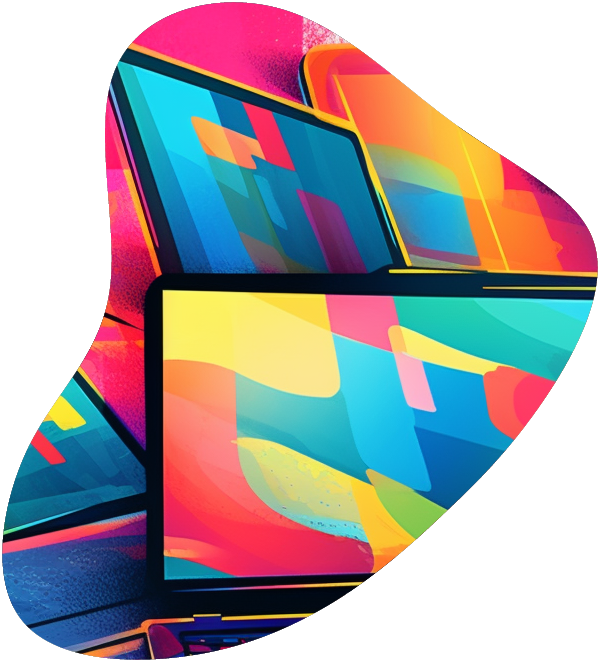There are many uses of Adobe Photoshop. It is a widely recognized and industry-standard software, is essential for graphic designers, photographers, and digital artists. It’s part of Adobe’s Creative Cloud suite and offers a comprehensive range of tools for editing, manipulating, and creating images and graphics. It’s more than just software; it’s a canvas for creatives in various fields. In this blog, we’ll dive deep into what makes Photoshop the go-to tool for professionals and hobbyists alike.
What is Adobe Photoshop?
Begin with an introduction to Adobe Photoshop, explaining its primary functions and its role in the Adobe Creative Cloud suite. Discuss its evolution over the years and how it has become a staple in digital creativity.
Understanding Photoshop’s Basics
At its core, Photoshop is a pixel-based image editor, allowing users to manipulate individual pixels to alter images. This capability makes it perfect for tasks like photo retouching, color correction, and creating complex photo compositions. With its layers feature, users can work on individual elements of an image separately without affecting the rest.
How to Use Photoshop
Outline the basics of starting with Photoshop. Discuss the user interface, including the toolbar, panels, and workspace. Provide insights into how beginners can navigate the software, emphasizing the importance of practice and experimentation.
Getting started with Photoshop involves learning its interface, which includes a toolbar, menu bar, panels, and a workspace. The toolbar contains tools for selecting, painting, retouching, and viewing images. Panels, like layers, history, and color, help manage and modify images. The workspace can be customized to suit different workflows and projects.
Editing and Retouching
Adobe Photoshop is renowned for its editing capabilities. Users can perform simple edits like cropping, resizing, and color adjustments, or more complex tasks like removing objects, correcting imperfections, and blending images. Features like adjustment layers and masking offer non-destructive editing, meaning you can make changes without permanently altering the original image. Delve into Photoshop’s capabilities in photo editing. Explain tools and techniques for tasks like color correction, object removal, and photo restoration. Include examples to illustrate how these tools are used in real-world scenarios.
Master Adobe with ITU
Explore ITU’s comprehensive Adobe courses and elevate your creative skills. From Photoshop to Illustrator, InDesign, and more, our expert-led tutorials are tailored for all levels. Whether you’re a beginner or a pro, ITU’s Adobe courses are your gateway to design mastery. Start your creative journey today!
Creating with Photoshop
Beyond editing, Photoshop is a powerful tool for creating original artwork. It offers a variety of brushes, shapes, and text tools, along with advanced features like 3D modeling and raster and vector support. Artists and designers can bring their creative visions to life, whether it’s for digital art, website design, or marketing materials.
Explore how Photoshop goes beyond photo editing. Discuss its use in creating digital art, including painting, drawing, and 3D modeling. Highlight features like brushes, layer styles, and blending modes.
Advanced Features
Photoshop’s advanced features cater to professionals needing more sophisticated tools. Layer styles and blending modes allow for intricate composites. The pen tool provides precision in creating paths and selections. Adobe Photoshop CC, the latest version, continually introduces new features like AI-powered tools for even more efficient workflows. For the more advanced users, delve into complex features
Pen Tool Tips & Tricks
- Start with Basic Shapes : If you’re new to the Pen Tool, begin by tracing basic shapes. This practice helps you get comfortable with clicking and dragging to create curves.
- Use the ‘Alt’ Key: The ‘Alt’ key (Option on Mac) is crucial for controlling anchor points and handles. You can use it to break the direction of handles, creating sharp corners or changing the direction of your curves.
- Add and Remove Points Judiciously : Don’t overdo it with anchor points. A common mistake is to add too many points, which makes the path complex and harder to edit. Use the ‘Add Anchor Point’ and ‘Delete Anchor Point’ tools sparingly.
- Utilize the ‘Ctrl’ Key : Pressing ‘Ctrl’ (Command on Mac) allows you to switch temporarily to the Direct Selection Tool. This is handy for quickly adjusting anchor points and handles without changing tools.
- Practice Precision : For precise control over the Pen Tool, zoom in to place anchor points accurately. This is especially important for intricate designs.
- Learn Bezier Curves : Understanding how Bezier curves work is key to mastering the Pen Tool. Practice creating different shapes and curves to get a feel for how the handles and anchor points interact.
Advanced Layer Management Tips & Tricks
- Use Layer Group s: Organize your layers into groups to keep your workspace tidy and manageable. This is especially helpful in complex projects with many layers.
- Color Code Layers : Assign colors to similar layers or groups for quick identification. This visual organization can speed up your workflow.
- Leverage Layer Mask : Instead of erasing parts of a layer, use layer masks. They allow for non-destructive editing, meaning you can always revert back if needed.
- Utilize Blending Modes : Experiment with different blending modes to achieve various effects. Blending modes can drastically change the look of your layers when they interact with each other.
- Link Layers : When you need to move or transform multiple layers together, link them instead of merging. This maintains their individual properties while allowing them to be edited as a unit.
- Adjustment Layers for Non-Destructive Edits : Use adjustment layers for color correction and photo retouching. They are non-destructive and can be modified or removed at any time.
- Smart Objects for Scalability : Convert layers to Smart Objects to preserve their quality when scaling up or down. This is especially useful for vector graphics and complex compositions.
- Use Layer Comps : For projects that require different versions (like a web design with different layouts), use Layer Comps to save the state of your layers. This lets you switch between different compositions quickly.
Uses of Photoshop in Various Industries
1. Photography
- Photo Editing and Enhancement: Photoshop is essential for photographers to edit and enhance their images. It’s used for color correction, exposure adjustment, retouching, and adding creative effects.
- Restoration of Old Photographs: Photoshop helps in restoring old, damaged photographs by removing scratches, adjusting colors, and improving clarity.
- Creating Photographic Composites: It allows photographers to create composite images by combining elements from different photographs to create a new, unique image.
2. Graphic Design
- Logo Design: Photoshop is used for designing logos and branding materials, though often in conjunction with vector-based software like Adobe Illustrator.
- Web and App Design: Designers use Photoshop to create layouts, banners, and graphical elements for websites and mobile apps.
- Print Design: It’s used for creating graphics for brochures, posters, and other print materials.
3. Fashion Industry
- Fashion Design: Designers use Photoshop to create and modify designs, playing with colors, patterns, and fabrics digitally before the actual production.
- Fashion Photography Editing: Retouching photos from fashion shoots, including adjusting colors, enhancing makeup, and editing background elements.
4. Film and Television
- Pre-visualization and Storyboarding: Creating storyboards and concept art to visualize scenes before filming.
- Special Effects and Post-Production: Used in post-production for editing stills, creating promotional materials, and sometimes even for generating visual effects.
5. Advertising and Marketing
- Ad Campaigns: Creating visuals for advertising campaigns, including print ads, billboards, and digital ads.
- Social Media Content: Designing eye-catching graphics for social media marketing campaigns.
6. Web Design
- Mockups and Wireframes: Photoshop is used to create mockups and wireframes for websites, providing a visual representation of the site before it is developed.
- Web Graphics: Creating customized buttons, icons, banners, and other graphical elements for websites.
7. Publishing
- Book Cover Design: Designers use Photoshop to create compelling book covers and layouts.
- Magazine Layout: It’s used for designing the layout of magazines, including photo placement, text arrangement, and overall aesthetic.
8. Architecture and Interior Design
- Visualizations: Creating visualizations of architectural and interior design projects by editing and enhancing images of models or renderings.
- Client Presentations: Preparing visual presentations for clients, showing how a space or building will look after construction or renovation.
9. Art and Illustration
- Digital Art: Artists use Photoshop to create digital paintings, illustrations, and artwork.
- Mixed Media Art: Combining traditional art techniques with digital editing for unique mixed media artworks.
10. Video Games
- Game Design: Creating textures, backgrounds, and other elements for video games.
- Concept Art: Generating concept art to guide the visual style of a game.
11. Medical Imaging
- Research and Presentation: Enhancing clarity and detail in medical images for research and presentations.
12. Forensics
- Image Analysis: Enhancing and analyzing images for use in forensic investigations.
Web Designer Career Path
Our Web Designer Career Path training series is thoughtfully curated to cater to this growing need, offering an all-encompassing educational journey for those aspiring to thrive in the realm of web design. This series offers an in-depth exploration of both the theoretical foundations and practical applications of web design, ensuring participants are fully equipped to craft engaging and functional websites.
Conclusion
As we have explored, Adobe Photoshop stands as an unrivaled tool in the realm of digital creativity, offering an extensive array of features that cater to diverse artistic needs. The Pen Tool and advanced layer management, in particular, exemplify Photoshop’s versatility and depth, providing users with the precision and control necessary for sophisticated graphic work.
The Pen Tool is more than just a drawing instrument; it’s a gateway to unparalleled accuracy and creativity in digital design. Its ability to create crisp, vector-based paths and shapes makes it indispensable for graphic designers and illustrators. The skillful manipulation of anchor points and handles with the Pen Tool allows for the creation of intricate designs and precise selections, essential for complex photo composites and high-quality artwork. Mastery of this tool demands patience and practice, but the payoff is significant, enabling artists to transform their most intricate visions into digital reality.
In tandem with the Pen Tool, advanced layer management stands as a cornerstone of efficient and effective Photoshop use. The ability to organize, manipulate, and blend layers in a non-destructive manner opens up a realm of creative possibilities. Layer groups and color coding streamline the workflow, making it easier to navigate complex projects. Layer masks and blending modes offer a level of control that encourages experimentation without the risk of permanent changes, fostering an environment where creativity can flourish unimpeded. The use of adjustment layers and smart objects further underscores the emphasis on non-destructive editing – a philosophy central to modern digital design practices.
These advanced features of Photoshop, while powerful, also underscore the importance of a foundational understanding of the software. They serve as a reminder that Photoshop is a tool of both precision and creativity, requiring both technical knowledge and artistic intuition. For beginners, these features may seem daunting, but they are integral to unlocking the full potential of Photoshop. For seasoned professionals, they offer a reminder of the software’s depth and capacity for growth and innovation.
As we conclude, it’s clear that Adobe Photoshop, with its sophisticated features like the Pen Tool and advanced layer management, is not just software but a canvas for imagination, a laboratory for experimentation, and a workshop for creation. Whether you are retouching photos, crafting design masterpieces, or bringing digital art to life, Photoshop stands as an indispensable ally. As technology continues to evolve, so too will Photoshop, promising ever more powerful tools for the artists, designers, and creatives who rely on it to bring their visions to life.
In essence, mastering Adobe Photoshop is a journey – one that challenges and rewards in equal measure. It’s a journey of constant learning, where each tool and feature opens new doors to creative expression. For those willing to explore its depths, Photoshop offers not just a set of digital tools, but a path to realizing the fullest potential of their creative abilities.
What makes Adobe Photoshop a preferred tool in professional photography?
Adobe Photoshop is favored in professional photography for its advanced editing capabilities, which include detailed color correction, sophisticated retouching, and the ability to create complex composites. Its non-destructive editing approach allows photographers to experiment without permanently altering the original image, making it a versatile tool for enhancing and transforming photographs.
How does Adobe Photoshop support graphic design across different industries?
In graphic design, Photoshop provides a robust platform for creating and manipulating a wide range of visual elements. It’s used for designing logos, web graphics, and print materials. Its layer-based editing system enables designers to build complex compositions with ease, making it a key tool in industries ranging from advertising to publishing.
Can Adobe Photoshop be used for web design and if so, how?
Yes, Adobe Photoshop is widely used in web design. It helps in creating website mockups, designing graphics like icons and banners, and preparing images for web use. Photoshop’s ability to handle pixel-based design makes it ideal for creating detailed and visually appealing web elements that are optimized for various devices and screen resolutions.
What role does Adobe Photoshop play in the fashion industry?
In the fashion industry, Photoshop is essential for editing and enhancing fashion photographs, designing fashion items, and creating promotional materials. It allows designers to experiment with different colors and patterns on their designs digitally, and it’s pivotal in retouching fashion photography to achieve the desired aesthetic.
Is Adobe Photoshop relevant in non-creative industries, and how is it applied?
medical imaging, it’s used to enhance and clarify images for research and diagnostics. In architecture, it helps in creating realistic visualizations of projects. Even in forensics, Photoshop assists in analyzing and enhancing images for investigative purposes.


























